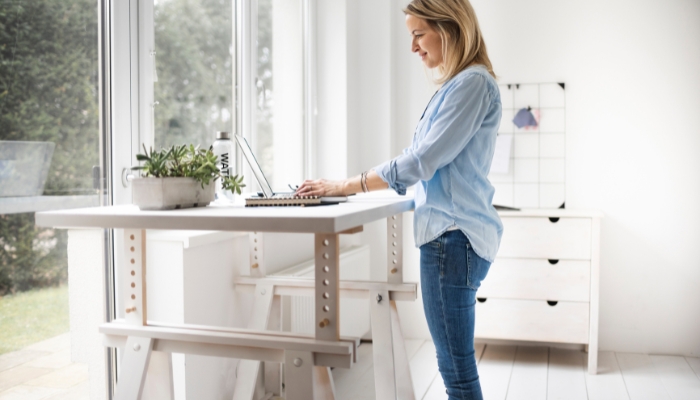Health
The Impact of Ergonomic Design on Workplace Wellness and Efficiency

- Ergonomic design reduces physical strain and enhances mental well-being, leading to healthier and more satisfied employees.
- Implementing ergonomic workspaces boosts productivity, reduces absenteeism, and leads to cost savings and improved employee performance for businesses.
In our fast-paced, competitive business world the importance of design of workplaces goes beyond aesthetics. How a workplace is organized can significantly impact the productivity and well-being of employees. Ergonomic designs, that concentrate on providing a relaxing, secure, efficient and safe space, plays an important contribution to improving both wellbeing and productivity.
This article explains how ergonomic design could transform working conditions which can lead to healthier employees and more profitable firms.
Understanding Ergonomic Design
Ergonomic design is about creating workplaces that meet the needs of those using the space. This covers everything from chair and desk height to the position of monitors for computers and the style of lighting for offices. The goal is to reduce stress on the body and improve your comfort while minimizing the possibility of injury, and increasing productivity.
Enhancing Workplace Wellness
- Lowering the strain on your body: One of the main advantages that ergonomic design offers is decrease of strain on the body. Workspaces that are poorly designed can cause chronic strain injuries (RSIs) like carpal tunnel syndrome, as well as lower back discomfort. Ergonomic chairs, adjustable desks and keyboards that are properly placed could help avoid these problems and ensure that employees are fit and healthy.
- Promoting mental health: An ergonomically designed workspace can have a positive effect on your well-being. Offices that are optimally designed often have elements which reduce stress and improve satisfaction. This includes natural light, comfortable seating and easily-organized workspaces. When employees feel relaxed and respected, their work satisfaction as well as their mental wellbeing increases.
- Promoting the movement: Ergonomic design promotes flexibility and movement. Sit-stand desks for instance allows employees to switch between standing and sitting throughout the day, which helps improve circulation, and decreases the chance of people gaining weight and health concerns. This innovative approach to work space design allows employees to stay actively engaged during the work day.
Boosting Efficiency
- Enhancing productivity: A well-designed workspace will significantly increase productivity. If employees feel comfortable and are free of physical pain and discomfort, they are able to concentrate better and perform their work with greater efficiency. The proper placement of monitors and desk arrangement can cut down on the time spent searching for equipment or searching for things which can result in more efficient processes.
- Improved focus: Design that is ergonomic reduces distractions while enhancing concentration. With a relaxing and neat environment, employees can focus on their jobs in a relaxed and comfortable environment without having to contend with uncomfortable surroundings or unnecessary clutter. A better focus can lead to better work quality and greater effectiveness.
- Reduces Absenteeism: Employees who are healthier tend to be less likely to use sick days. Through reducing the chance of workplace injuries, and encouraging overall health ergonomic designs help reduce the amount of time employees are absent. It not only helps employees, but it also ensures that companies can keep the same performance levels.
Business Benefits
- Cost savings: The investment in ergonomic equipment and furniture will result in substantial cost savings in the end term. The reduction in absenteeism as well as the lower cost associated with injuries from work means that companies spend less on medical bills as well as lost productivity.
- Improved satisfaction of employees: A relaxing and well-designed workplace can lead to greater satisfaction among employees. Happy employees will be more likely to stay within a company, thus reducing the rate of turnover and cost of hiring and training new employees.
- Better Efficiency of Employees: Designing ergonomically directly affects employee productivity. People who feel comfortable and at ease are more productive and productive, which leads to increased productivity as well as better overall performance. This in turn boosts business performance and increases growth.
Implementing Ergonomic Design
- Analyzing needs: First stage in the process of implementing ergonomic design is to determine the requirements of your employees. It could involve survey, monitoring workflows, as well as consulting with ergonomic specialists. Knowing the particular demands of your workers is essential to develop the most effective ergonomic strategy.
- Investing in quality Equipment: Investing in equipment and furniture that is ergonomic is vital. It includes tables with a sit-stand, adjustable chair as well as ergonomic keyboards and monitor stands. Though there could be an initial expense but the benefits over time regarding the health of employees and their productivity make an investment worth it.
- Learning and training: Training and information on ergonomics is also essential. Employees should know the advantages of ergonomic design as well as the proper way to adapt their workplaces. Workshops and seminars regularly held will help to reinforce these principles and help ensure that everyone benefits from the ergonomic workplace.
Conclusion
Designing ergonomically isn’t just an aesthetic choice; it’s an essential element of the healthiest and most efficient workplace. In focusing on the mental and physical well-being of workers through well-thought out design, companies improve productivity, lower absences, and provide an environment that is more conducive to work. In the years to come, we will be able to recognize how important the environment is to our performance and health. Investing in ergonomic design remains a crucial strategy for organizations that are forward-looking.

















































